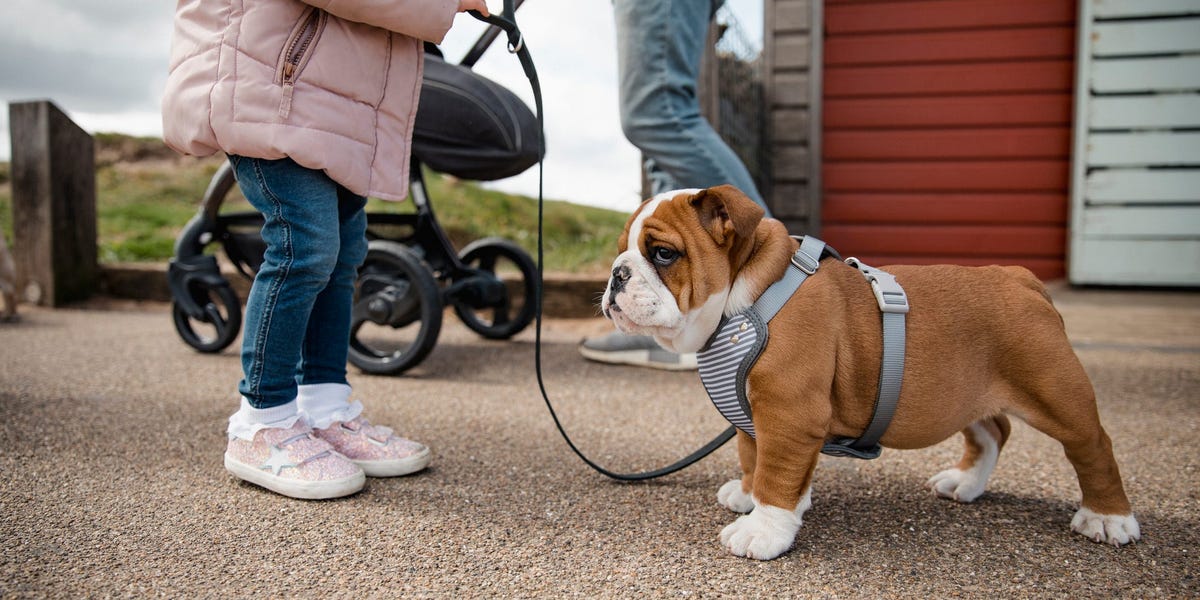- July 19, 2022
- No Comment
- 8 minutes read
Dog harness vs. collar: Safety pros and cons of each – Insider

No matter what type of dog you have, one thing’s for sure: They need to go out on walks. The two types of leash attachments that you can use are harnesses and collars.
Whether you just got a new dog and aren’t sure which to use or you are looking to switch things up, it’s important to know the pros and cons for both dog harnesses and collars before making a decision.
Harnesses reduce pulling: Harnesses cover the dog’s chest, shoulders, and upper back, which disperses pressure over a larger surface area than a collar giving you better control over your dog, says Carly Fox, DVM, Staff Doctor at New York City’s Animal Medical Center.
To reduce pulling even further, you can use a no-pull harness. “When the dog pulls, the tension on the leash causes them to turn back toward the owner. Dogs cannot move forward unless they slow down,” says Travis Arndt, DVM, director of the Animal Medical Center of Mid-America.
Harnesses do not put pressure on your dog’s neck: Since harnesses fasten over the dog’s chest and not around the neck, they do not put pressure on the trachea.
This makes them ideal for pets that have neck problems, a collapsing trachea, or restricted airways, says Arndt. A harness can also help prevent these issues from arising.
Harnesses tend to be more secure: Harnesses are generally better at preventing accidents because they fasten more securely around your dog’s body. While dogs can easily slip out of their collars and potentially run into traffic or another person’s yard, harnesses offer much more security and safety, says Fox.
Harnesses are less convenient: A collar can just slip on, but harnesses take more time to fasten.
Harnesses may not have a place for an ID tag: Some harnesses don’t have a place to carry a tag. It’s best to get a harness with a ring for a tag—or use both a collar with a tag and a harness when out walking.
Harnesses can be uncomfortable: Harnesses are bulkier than collars, so they can be more uncomfortable for your dog. Some dogs really don’t like wearing harnesses, so it can take time for them to get used to walking with one.
There are a few situations where you should absolutely be using a harness over a collar. Fox says four situations you should use a harness in are:
We test and recommend the best dog harnesses. Check out our picks:
Collars are more convenient: The main benefit of collars is that they can be left on at all times, says Fox, as opposed to a harness, which should only be worn during walks. And even if you choose not to leave your dog’s collar on at all times, it’s still much easier to snap a collar on and off than a harness.
Collars hold ID tags: Collars typically come with a metal ring where you can attach your pet’s ID tag with your address and/or phone number in case the dog gets lost.
Collars are not safe for dogs with certain medical issues: Avoid using collars to walk dogs with medical issues such as glaucoma, a history of proptosed eye, neck injuries, or spinal malformations, says M. Leanne Lilly, DVM, DACVB, Assistant Professor of Behavioral Medicine, Veterinary Clinical Sciences, at The Ohio State University.
She says you should check with your vet to see if your dog is healthy for a collar.
Collars are not safe for dogs that pull: If your dog constantly pulls against their collar, they can injure themselves or reduce the airflow they are getting. “All collars, when attached to a leash, create pulling on the trachea and vertebrae of the neck. With excessive pulling there is a risk of reducing airflow into the dog or creating pain by causing pressure on the pet’s vertebrae,” says Arndt.
Collars should not be used by certain breeds: Collars should not be used on toy breeds and brachycephalic breeds, says Arndt. Examples of toy breeds include:
Examples of brachycephalic breeds:
A collar may be more convenient to use if you’re going on a short walk or stepping outside quickly. It is okay to go on longer walks using a collar if your vet gives you the green light to do so.
Amazon
We test and recommend the best dog collars. Check out our picks:
Whether you use a harness or a collar for your dog depends on your dog’s health, and ultimately, your vet’s recommendation. Be sure to consult your vet to have a clear answer on which you should use to make sure that you keep your dog as healthy and safe as possible.
We may receive a commission when you buy through our links, but our reporting and recommendations are always independent and objective.

